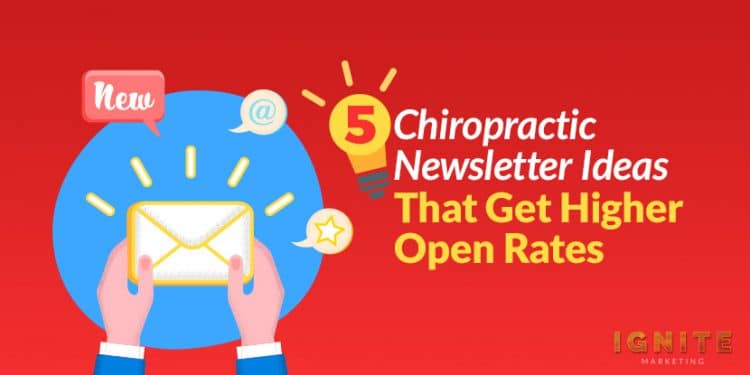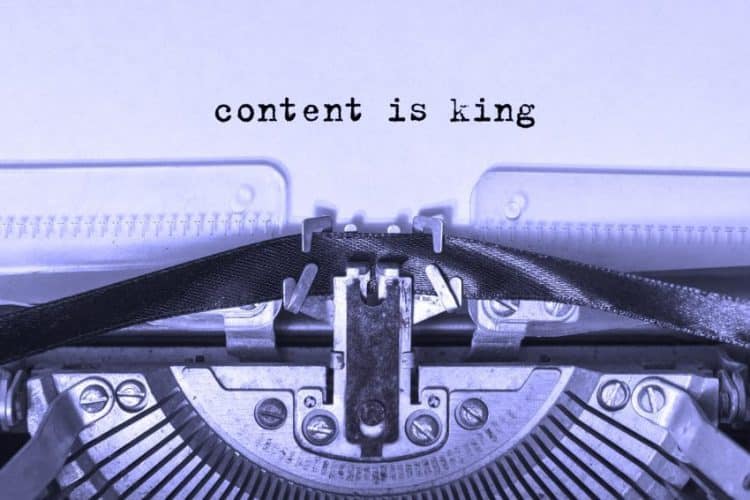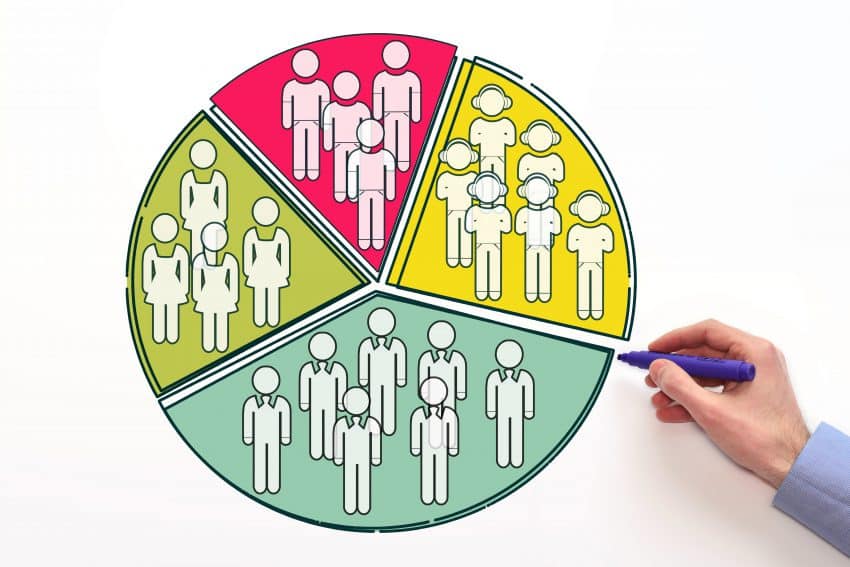


If you’re sending out a regular newsletter for your chiropractic practice, you already know how useful they can be.
A good newsletter will make non-patients who join your list through a signup form more likely to come in for a visit. It also works wonders for retaining fresh patients and convincing people who haven’t visited in a while to resume their chiropractic care.
Your amazing and informative newsletters can’t get patients in the door if no one opens them though.
To boost your new and returning patient counts, you can use these 5 chiropractic newsletter ideas that get higher open rates.
The subject line of your emails is the most important part of your newsletter campaign.
I know that’s a bold claim. It’s true though ‒ here are a couple of email subject line stats to back that statement up:
And remember, the email subject line still greatly impacts the 53% of recipients who don’t base their open decision on the subject line alone. They just happen to take the sender and the initial snippet text into account too.
Alright, I think you get it. The email subject line is super important. Without a subject line that captivates the reader and convinces them to open your message, none of the painstakingly crafted body content you’ve written will matter at all.
So how do you write a subject line that captivates readers and encourages them to open your email?
Well, it’s not exactly the easiest thing to master and there’s a good reason email copywriters consistently earn 6-figure salaries. However, there are some concrete and actionable tips you can use to improve your subject lines ‒ and your open rates.

I don’t know about you, but I have a pretty short attention span when it comes to my email inbox. I rarely give more than half a second of my attention to any of the emails that pile up in my inbox on a daily basis.
I’m not alone in this. Most people have no time to do anything but briefly skim through the dozens or hundreds of emails that pop up in their inbox every single day. And with the average email user receiving a whopping 88 emails per day, that’s completely understandable.
To make the most of this half-second of your readers’ attention, you need to make your subject line short and easily digestible.
I’m not just saying this ‒ the data backs this up. Here are the results of a study investigating how email subject lines impact open rates.
As you can see, shorter subject lines result in higher open rates. Email subject lines with 6-10 words are opened the most, and even shorter subject lines with 0-5 words come are opened the second-most.
One tip in particular that can help you craft shorter subject lines is to use words that don’t have many syllables. Try to stick to one or two-syllable words whenever possible. It’s okay to use words that have three or more, but make sure the longer word is really needed before throwing it in there.
Although it’s tempting to label your chiropractic newsletter a “newsletter” when sending it to patients and prospects, doing so would harm your open rates. Email open rates drop by as much as 19% when the word “newsletter” appears in the subject line.
While calling your regular series of value-filled emails a newsletter is a proper way to describe it, the term doesn’t really evoke excitement in your readers. The phrase reminds me of a dry, to-the-point relaying of facts ‒ kind of like an article in a newspaper. If you need to refer to your newsletter in the subject line, try using a more exciting word instead.
When possible, you should use specific pieces of data in your subject line. Here are a few examples:
Writing good subject lines will get your subscribers to open your first few emails. But if the content inside isn’t genuinely helpful, readers will quickly learn to ignore what you send them.
So, what do your readers want from your chiropractic email newsletter?
To answer this, we need to go back to the foundational concept that underlies the entire marketing industry: people only care about themselves.

By applying this concept to the framework of chiropractic email marketing, we can understand what it is your patients want from your chiropractic services. And the answer is always the same: pain relief.
The best chiropractic email newsletters will offer actionable, easy-to-follow advice for how readers can relieve the various kinds of pain they feel throughout the day. You can also provide some background knowledge on why people feel certain types of pain, and explain how regular chiropractic care can help them heal that pain.
Here are a few examples of chiropractic email topics that will keep your readers opening your emails for years to come:
When you’re writing your content, don’t just throw in random tips without explaining why they help. Anyone can go on Google and search up “stretches to relieve back pain.”
By using your expertise as a chiropractor and explaining on a physiological level how certain stretches relieve pain, you’ll be going above and beyond to provide your readers with genuinely useful information that they didn’t know before.
One more way you can improve the helpfulness of your content is by simplifying your writing. The average internet user engages most with content that is easy to read. If you use big words or complex sentence structures, readers aren’t going to engage with your emails at much.
To help you simplify your writing, you can use the following tips:
If you’re not sure whether your content is simple enough, you can use an automatic readability checker to figure it out.
No matter how interesting you make your subject lines or how helpful you make your content, there will always be a subset of your email list that simply doesn’t want to read your emails or engage with you.
There are quite a few reasons they might not be opening your newsletter.
Whatever the reason is, they need to be culled from your list to provide you with a more accurate view of your open rate statistics. You should only be interested in how your emails are performing with people who have a history of recently interacting with your emails. If you allow these inactive subscribers to remain on your list, they will muddy the waters and make you think your emails are less popular amongst your active subscribers than they really are.
A good rule of thumb is to remove any subscribers who haven’t opened your content in at least six months. Your email marketing service provider should be able to automate inactive subscriber deletion. If you aren’t sure how to do this, your provider’s customer support can help you set it up.
Your email list is comprised of all sorts of different people. They are all subscribed to your list because they are interested in how chiropractic care can help them. But within these shared interests are a bunch of different sub-interests.

If you’re up to the task, writing content specifically targeted at a certain segment of your list will help you get higher open rates.
There are some pieces of content for which segmentation might not be suitable though.
For example, almost everyone suffers from neck pain because of how often we use our computers and smartphones. Many of your patients who primarily see you for back pain or injury recovery would still be interested in content about relieving neck pain. Restricting that content to the subset of your email list who see you primarily for neck pain would be wasteful.
And even if restricting content with a universal appeal does slightly improve your open rates, the lower number of people you’re reaching with the content will make it less effective at converting and retaining prospects and patients.
One of the biggest obstacles to a stellar email open rate is the dreaded spam folder.
If email service providers (Gmail, Yahoo, etc.) think most of the emails you send are spam, they’ll automatically relegate your emails to the spam folder. This will tank your open rates, as the people on your list will never even see your emails hit their inbox.
While there are automatic indicators that an email is spam, many email service providers use user spam reports to determine whether an email is valid or not.
Before we discuss how to keep your emails out of the spam folder, you first need to understand why users mark emails as spam. Here are some of the most common reasons:
Now that you know why emails get reported as spam, you can employ some email marketing best practices to ensure your chiropractic email newsletter always reaches your readers’ inboxes.
One of the best ways to stay out of the spam folder is to get your subscribers to whitelist you in their email service provider. Once they do this, your emails will always reach their inbox regardless of what you send them.
The best place to ask your subscribers to whitelist you is in your initial welcome email. This will ensure that all of your subsequent emails reach their inbox instead of the spam folder.
If you’re concerned that your emails are going straight to the spam folder, you can use a spam checker to see how “clean” your emails are. A good spam checker will also tell you exactly how to improve your emails to decrease your chances of getting marked as spam.
There is a collection of words that spammers often use to trick people into opening their emails. If you use one of these words in your subject line or body, it will increase the chances of email service providers marking your email as spam.
Here are some of the most common spam trigger words:
Improving your chiropractic newsletter open rates is easier said than done. While the tips I mentioned in this article will certainly get more people to open your emails, implementing a lot of this stuff is challenging and time-consuming.
If you’d like some professional help with improving your open rates, you can schedule a free consultation with one of the chiropractic marketing experts at Ignite Marketing. We work exclusively with chiropractors and know exactly what to do to boost your newsletter open rates to the highest percentage possible.
